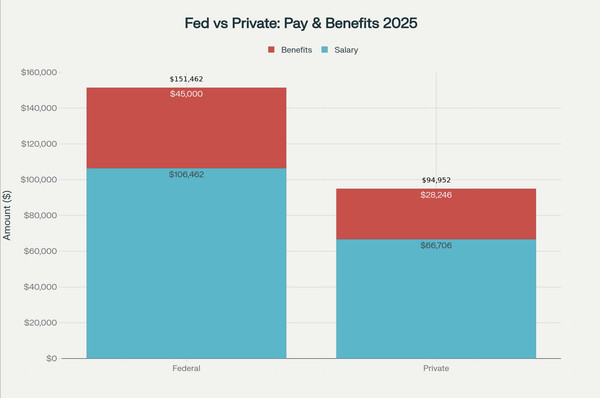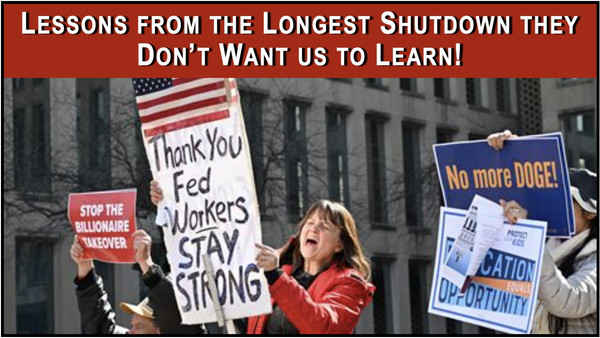Less Government, Better Government? Lessons from the Longest Shutdown
We STILL Need to Get Rid of the Senate Filibuster- Click Here to find out Why and CALL YOUR SENATOR TODAY!
by Amuse, November 8, 2025
The longest government shutdown in US history has yielded an unexpected revelation: our federal workforce is far larger than our daily functioning requires. For weeks, nearly half of all federal employees were told not to report to work. Yet planes continued to fly, mail was delivered, and the country endured with only mild inconvenience. This is not to downplay the hardship experienced by families missing paychecks, but to confront a deeper truth about how many federal positions may be superfluous. When 670,000 workers can be furloughed while 730,000 others continue operating the essential machinery of the state, it raises a question that transcends partisan lines: what, precisely, are we paying for?
The term “non-essential” is not a political label; it is the government’s own classification. During a funding lapse, each agency distinguishes between what must continue and what can pause. Air traffic controllers, border patrol, and military personnel keep working. Offices that issue grants, review environmental paperwork, or manage social media accounts do not. Yet the republic remains intact. This empirical test, an unplanned experiment in government minimalism, suggests a mismatch between the size of the federal payroll and the scope of truly critical functions. The lesson is not that all those furloughed jobs are useless, but that our expectations of indispensability may be overstated. A government that can operate for a month with half its workforce idle can almost certainly operate permanently with fewer employees and more efficient structures.
Consider the human dimension revealed during this shutdown. News outlets profiled furloughed employees in an effort to elicit sympathy. Yet the stories often did the opposite. One Internal Revenue Service attorney, earning a six-figure salary, spent the furlough investing $12,000 in a hot dog stand he dubbed “Shysters.” He sold about sixty hot dogs a day, grossing perhaps $600, and admitted he had not turned a profit. This is not the behavior of someone on the financial brink. Another federal IT specialist spent her downtime self-publishing “cat fantasy” novels that netted less than $100. These are creative pursuits, but they also suggest that federal employment has insulated some workers from market reality. In a robust economy where skilled coders and analysts are in high demand, one might expect rapid reentry into private work. Yet many furloughed employees chose not to pursue such opportunities, either because they possessed ample savings or because their government-specific expertise was not easily transferable. Both possibilities point to structural inefficiency—either compensation so generous it dulls initiative or skill specialization so narrow it lacks relevance outside bureaucracy.
Click Here to Watch/Listen to the Newest We the People Convention Weekly News & Opinion Podcast!
This pattern aligns with broader data. The Government Accountability Office has long identified overlapping programs, redundant offices, and misaligned missions. Since 2011, its recommendations have saved or recovered over $700 billion, with billions more in potential efficiencies still unrealized. The Committee for a Responsible Federal Budget estimates that reducing the civilian workforce by just 10% could save $350 billion over a decade, even accounting for exceptions in revenue-collecting or enforcement roles. If the workforce were trimmed by a quarter, nearly $1 trillion could be saved. Those figures are not abstract. They represent hospitals unbuilt, schools unfunded, or national debt unpaid because resources are absorbed by bureaucracy rather than directed toward outcomes.
Critics of reform argue that federal workers are underpaid compared to private-sector counterparts. The evidence says otherwise. According to the Bureau of Economic Analysis, the average federal civilian worker earned about $157,000 in combined wages and benefits in 2023, while the private-sector average was around $94,000. That is a 67% premium, largely driven by benefits such as defined pensions, paid leave, and health coverage far more generous than what most Americans receive. The Congressional Budget Office, controlling for education and job type, still finds that federal benefits outstrip private equivalents by nearly 50%. And these advantages come with near-total job security: only about 0.25% of federal employees are fired in a given year. In most agencies, a worker is statistically more likely to die of natural causes than be dismissed for poor performance. No private firm could operate that way.

This insulation from accountability breeds inertia. The quit rate in the federal government is roughly one-fourth that of the private sector. Once inside, few leave. The result is a culture where innovation is stifled, productivity is flat, and complacency is normalized. The shutdown inadvertently made this visible. Many of those labeled “non-essential” simply waited, confident they would receive full back pay when the impasse ended. And they were right. That back pay, guaranteed by statute, transforms a shutdown into what amounts to a taxpayer-funded vacation for some. When this is combined with lifetime benefits and low dismissal risk, the incentive for efficiency dwindles.
The American public senses this imbalance. Polls consistently show majorities describing the federal government as wasteful and inefficient. The shutdown, far from dispelling that perception, reinforced it. The sight of agencies idled without catastrophe invites comparison to a business discovering that half its staff can vanish with no loss in service. It does not mean those employees are unskilled or lazy, but that the organization has grown detached from market discipline. In the private sector, competition ensures that inefficiency is punished. In government, inefficiency is often rewarded with larger budgets, more hires, and new layers of management. Each layer brings costs that compound year after year.
We must "Never Let a Crisis Go to Waste" - CUT "NON-ESSENTIAL GOVERNMENT NOW!
To be clear, none of this diminishes the dedication of truly essential personnel. Border agents, air traffic controllers, law enforcement officers, and active-duty military continued serving without pay. They represent the backbone of national competence. But that contrast itself underscores the problem. The workers most vital to national functioning are often paid less and treated worse than those whose tasks can be suspended indefinitely. A system that rewards administrative proliferation while straining its essential core is unsustainable.
The goal, then, is not cruelty toward public servants but clarity about public purpose. “Rightsizing” the government means aligning resources with necessity, not ideology. It means distinguishing between what must be done by the state and what could be better handled by markets, communities, or automation. The shutdown revealed that the dividing line is wider than most imagined. If half the workforce can disappear for weeks without disaster, perhaps one-quarter could disappear permanently with improvement. Agencies could consolidate overlapping missions. Layers of review could be collapsed. Performance-based accountability could replace tenure-based security. Savings could be redirected toward infrastructure, research, or debt reduction—endeavors that enhance national strength rather than administrative comfort.
Skeptics might warn that such cuts would erode morale or impair service. But morale grounded in permanence rather than purpose is not the kind worth preserving. True morale comes from knowing that one’s work matters. The essential workers who endured the shutdown without pay displayed that morale. They worked because duty compelled them, not because HR rules guaranteed them. A leaner government that prizes merit over seniority would elevate, not degrade, that spirit.
Click Here to Donate to Support the Mission of the We the People Convention to Protect and Defend our Individual Freedom, Liberty and Prosperity!
This debate is not new. Every major administration has flirted with civil service reform, only to retreat in the face of political inertia. But Trump’s second term, marked by a willingness to challenge bureaucratic norms, presents an opportunity to confront it directly. Streamlining the federal workforce is not about punishment or partisanship. It is about efficiency, accountability, and respect for taxpayers. The shutdown, for all its pain, offered an empirical argument that can no longer be ignored. The United States ran on half power and did not crash. That fact should guide reform far more than sentimental defenses of the status quo.
In the final analysis, less government can mean better government. The private sector has long known that lean operations outperform bloated ones. The same logic applies to the public sector. When agencies grow for their own sake, citizens pay twice, once in taxes and again in lost agility. The longest shutdown in history has revealed the size of the opportunity before us. We briefly flirted with this concept when President Trump brought in Elon Musk and his DOGE team to streamline the federal government. Their work was met by a bipartisan buzzsaw and ultimately scuttled. Republicans paid a political price for abandoning Musk and DOGE, as the November 4th elections last week showed. Yet the shutdown has once again proven that we can do more with less. If Republicans step up and resurrect the DOGE project, they will not only strengthen the country but likely be rewarded by voters in the midterms. The choice, as always, belongs to the people.

